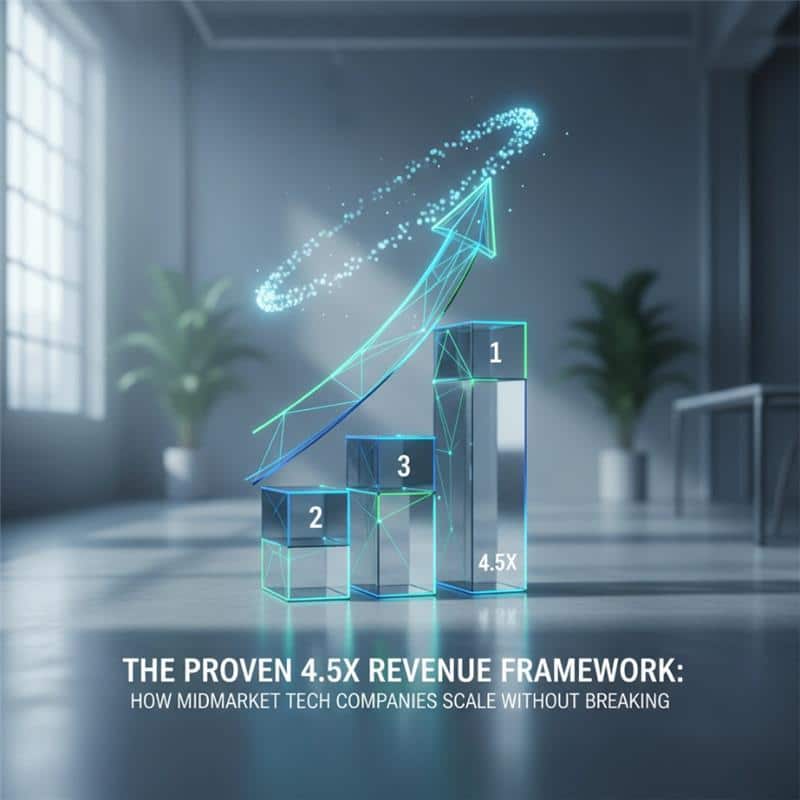
Picture this: You’re the founder of a promising tech company in Pune, India. You’ve crossed the $2M ARR mark, your team is buzzing with energy, and investors are finally taking your calls. But here’s the catch, you’re stuck. Growth has plateaued, your AWS bills are spiraling, and every new hire seems to create more chaos than value.
Sound familiar? You’re experiencing what we call “the midmarket trap”, that awkward phase where you’re too big to be a scrappy startup but too small to have enterprise-level systems. It’s like trying to drive a bullock cart on the expressway.
This is where our 4.5x Revenue Framework comes in. Over the past five years working with midmarket tech companies across India, ASEAN, and the Middle East, we’ve cracked the code on sustainable scaling. Companies that implement this framework typically see 4.5x revenue growth within 18-24 months, without the usual growing pains.
The Anatomy of the 4.5x Revenue Framework
The framework rests on five interconnected pillars, each designed to multiply your revenue impact while maintaining operational sanity:
Revenue Architecture Redesign (The Foundation)
Most midmarket tech companies approach revenue growth consulting for tech companies like adding more fuel to a leaky engine. They hire more salespeople, pump up marketing spend, and wonder why revenue doesn’t scale proportionally.
The first pillar focuses on architectural changes, not tactical tweaks. Think of it like renovating your house instead of just repainting the walls.
Real Example: A Chennai-based SaaS company was stuck at $3M ARR despite doubling their sales team. Through our collaborative advisory model, we discovered they were targeting many (7-8) different customer segments with the same generic pitch. We consolidated this to 3 high-value segments, redesigned their pricing architecture, and saw them hit $8.2M ARR within 24 months.

Partner Ecosystem Multiplication (The Leverage)
Here’s where partner ecosystem growth strategy becomes your secret weapon. Instead of building everything in-house, smart midmarket companies create multiplier effects through strategic partnerships.
For tech companies, this often means AWS partner transformation consulting. We’ve seen companies 5x their cloud revenue by moving from basic AWS partnerships to specialized competencies. It’s like the difference between running a small general store versus becoming the authorized dealer for a premium brand.
The ecosystem approach works because:
- Partners bring pre-qualified leads
- Shared resources reduce operational costs
- Combined expertise creates competitive moats
- Risk distribution across multiple channels
The Ecosystem Sweet Spot: Aim for 30-40% of revenue coming through partner channels. Less than that, and you’re over-dependent on direct sales. More than that, and you lose control of customer relationships.
AI-Powered Practice Development (The Differentiator)
Every midmarket tech company today faces the same question: “How do we build credible AI and cloud practice growth consulting capabilities without betting the farm?”
Our Mindful Intelligence consulting framework addresses this through a measured approach. Instead of trying to become the next OpenAI, focus on becoming the AI integration specialist in your domain.
Case Study: A Mumbai-based systems integrator was losing deals to AI-native competitors. Rather than building AI from scratch, they developed AI-powered optimization tools for their existing ERP implementations. Their win rate jumped from 20% to 45%, and average deal size increased by 120%.
The key is treating AI as an amplifier, not a replacement. Think of it as adding a turbocharger to your existing engine rather than buying a completely new car.
GTM Strategy Acceleration (The Engine)
Traditional GTM strategy for cloud and AI services follows a linear path: Product → Marketing → Sales → Customer Success. The 4.5x framework flips this model entirely.
We start with the customer outcome and work backwards. What specific business result does your solution deliver? How quickly can prospects see this value? What’s the shortest path from “hello” to “aha moment”?
The Indian Context: In markets like India and Southeast Asia, relationship-first selling still dominates. Your GTM strategy needs to account for longer relationship-building cycles while maintaining velocity. It’s like playing chess instead of checkers, more moves, but strategic depth pays off.
Execution-Driven Operations (The Sustainer)
The difference between successful scaling and chaotic growth lies in execution-driven business consulting principles. Most companies focus on what to do; we obsess over how to do it consistently.

This means:
- Standardized processes that can handle 3x current volume
- Predictable outcomes from every department
- Scalable systems that don’t require constant founder intervention
- Cultural frameworks that maintain quality as you grow
The SMB Revenue Acceleration Catalyst
What makes this framework particularly effective for SMB revenue acceleration consulting is its focus on practical implementation over theoretical perfection.
Unlike enterprise transformation projects that take 18 months to show results, midmarket companies need wins every quarter. The 4.5x framework delivers incremental victories that build momentum:
Quarter 1: Foundation setting and quick wins (typically 15-25% revenue boost)
Quarter 1-2: System optimization and partner activation (additional 30-40% growth)
Quarter 2: AI integration and GTM refinement (compounds to 2.8x baseline)
Quarter 2-3: Scale optimization and ecosystem expansion (reaches 4.5x target)
Why Geography Matters: The India-ASEAN-Middle East Advantage
As a scale-up consulting firm India ASEAN Middle East, we’ve learned that regional context significantly impacts scaling strategies. What works in Silicon Valley doesn’t always translate to Hyderabad or Singapore.
Regional Scaling Insights:
- India: Relationship-heavy sales cycles, cost-conscious buyers, high technical talent availability
- ASEAN: Diverse regulatory environments, relationship-first business culture, growing digital adoption
- Middle East: Government-led digital transformation, oil money creating tech investment, cultural sensitivity requirements
Companies that acknowledge these regional nuances while maintaining global standard processes typically outperform their peers by 2.3x.
The Collaborative Advisory Difference
Traditional consulting follows a “sage on the stage” model, experts fly in, analyze, recommend, and fly out. Our collaborative advisory model embeds alongside your team, sharing both risks and rewards.
This approach works because:
- Skin in the game: Our success is tied to your outcomes
- Knowledge transfer: Your team learns while we implement
- Cultural fit: We adapt our methods to your organizational DNA
- Sustained impact: Changes stick because they’re co-created, not imposed
Making It Happen: Your 90-Day Sprint
Ready to implement the 4.5x Revenue Framework? Start with this 90-day sprint:
Days 1-30: Revenue Architecture Assessment
- Audit current revenue streams and customer segments
- Identify consolidation opportunities
- Map customer lifecycle and identify friction points
Days 31-60: Partnership and Practice Development
- Evaluate potential strategic partners
- Design AI integration roadmap for your domain
- Begin AWS or cloud competency development
Days 61-90: GTM and Execution Optimization
- Redesign sales processes for scalability
- Implement predictable growth systems
- Establish performance measurement frameworks

The beauty of this framework isn’t just the revenue multiplication, it’s the sustainable growth foundation you build along the way. Companies that complete this implementation typically find themselves more resilient, more competitive, and more valuable.
Your Next Move
Scaling a midmarket tech company is like learning to ride a motorcycle after years on a bicycle. Same basic principles, but everything happens faster and the stakes are higher. The 4.5x Revenue Framework gives you the training wheels you need until muscle memory kicks in.
If you’re ready to move beyond the midmarket trap and unlock predictable, scalable growth, let’s chat. At CUSP Services, we’ve guided over 150 midmarket tech companies through this exact transformation across India, ASEAN, and the Middle East.
The question isn’t whether you can 4.5x your revenue, it’s whether you’re ready to do it without breaking your company in the process.
Ready to explore how the 4.5x Revenue Framework can transform your midmarket tech company? Let’s start a conversation about your scaling journey.
FAQ: The 4.5x Revenue Framework
What makes midmarket tech companies different from startups or enterprises?
Midmarket tech companies (typically $2M-$20M revenue) face unique challenges, they've outgrown startup agility but lack enterprise resources. They need systems that scale without over-engineering.
How realistic is 4.5x revenue growth in 18-24 months
Based on our experience with 150+ companies, this target is achievable when you focus on architectural changes rather than tactical improvements. Most companies see 15-25% growth in the first quarter alone.
Which pillar of the framework delivers the fastest results?
Revenue Architecture Redesign typically shows immediate impact (30-60 days), while Partner Ecosystem Multiplication takes 90-120 days but delivers more sustainable long-term growth.
Is this framework applicable across different tech verticals?
Yes, we've successfully implemented it across SaaS, cloud services, AI consulting, systems integration, and digital transformation companies. The principles adapt while the framework remains consistent.
What's the typical investment required to implement this framework?
Implementation varies based on company size and current systems, but the ROI typically exceeds 8:1 within the first 18 months. Most companies break even on their investment within 4-6 months.
How does the framework address the specific challenges of scaling in India, ASEAN, and Middle East markets?
The framework incorporates regional business cultures, regulatory requirements, and customer behavior patterns specific to these markets, while maintaining global scalability standards.


